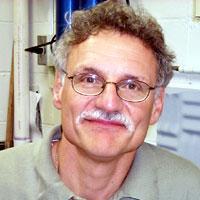Bruce Branchini
Hans and Ella McCollum '21 Vahlteich Professor of Chemistry
Joined Connecticut College: 1986
Education
M.A., Johns Hopkins University
Ph.D., Johns Hopkins University
Development of improved reagents for imaging genetic activity
Synthesis of bioluminescent compounds
Protein nuclear magnetic resonance
Bruce Branchini's major research interests focus on the biochemistry of bioluminescence - the emission of light by living organisms. He also studies the determination of protein structure using nuclear magnetic resonance instrumentation. He teaches courses in biochemistry and organic chemistry, including spectroscopic methods, both lecture and laboratory.
Bioluminescence is a natural phenomenon that has fascinated children, challenged those who have tried to understand it and provided the basis for an important research tool that has been applied in ways beneficial to human health. Professor Branchini has worked with undergraduates, research assistants and research scientists for approximately 30 years investigating the basic biochemistry leading to the emission of light by the firefly.
His bioluminescence research groups have collected specimens in Tennessee, Wisconsin, Texas, the Connecticut College Arboretum and Bologna, Italy. They have developed novel methods for purifying the protein that catalyzes the light-emitting reaction. They have also used synthetic organic techniques to prepare novel substrates for the firefly protein (luciferin) and substrates for a bioluminescent jellyfish that emits blue and green light. Most recently, his lab is using molecular biology methods to produce mutant luciferase proteins with properties that are desirable for such applications as drug screening, mechanistic studies and in vivo imaging.
Branchini's prior work with nuclear magnetic resonance (NMR) instrumentation has been conducted in collaboration with scientists at the University of Washington-Seattle and Pfizer Central Research and the Center for Magnetic Resonance at the University of Florence, Italy. These efforts have led to the determination of the structure of a phosphorylated bacterial protein and cytochrome b5.
The NMR research was integrated, in part, into a course he teaches: "Organic Spectroscopic Methods." The lecture material in this course is integrated closely with the laboratory work. In the lecture, students learn first-hand the methods of structure determination using infrared, ultraviolet-visible, NMR, and mass spectroscopy. In the laboratory, they apply these methods to identify complex organic unknowns. Branchini also participated in a Travel and Research Program (TRIP) with eight chemistry majors, Spectroscopy in Florence in Spring, 2001 and led a SATA Florence 2003 program.
Branchini and colleague Timo Ovaska also obtained NSF funding to purchase a Varian 500 MHz spectrometer to be incorporated into his research and teaching activities. An award from the National Science Foundation's Research in Undergraduate Institutions program also funds summer stipends for students who work with Branchini on his bioluminescence research. With NSF support he took students to Bologna, Italy in 2005-2007 to conduct bioluminescence research at the University of Bologna in the laboratory of his colleague Professor Aldo Roda. The U.S. Air Force Office of Scientific Research also supports his research.
Branchini received an Air Force Office of Scientific Research award in 2007-2009 for equipment and research and in 2010, was awarded a $225,000 Air Force Office of Scientific Research (AFOSR) grant to continue his cutting-edge research on bioluminescence.
Branchini received the 2002 Nancy Batson Nisbet Rash Faculty Research Award. Presented annually at Convocation, the award provides a research fund to one of the most outstanding and highly regarded members of the faculty. Read his remarks at Digital Commons, "Why Should Students Do Research?"
Visit the chemistry department website and the Branchini Bioluminescence Research Group.
Contact Bruce Branchini
Mailing Address
Bruce Branchini
Connecticut College
Box # CHEMISTRY/Hale Laboratory
270 Mohegan Ave.
New London, CT 06320
Office
121 Hale Laboratory
